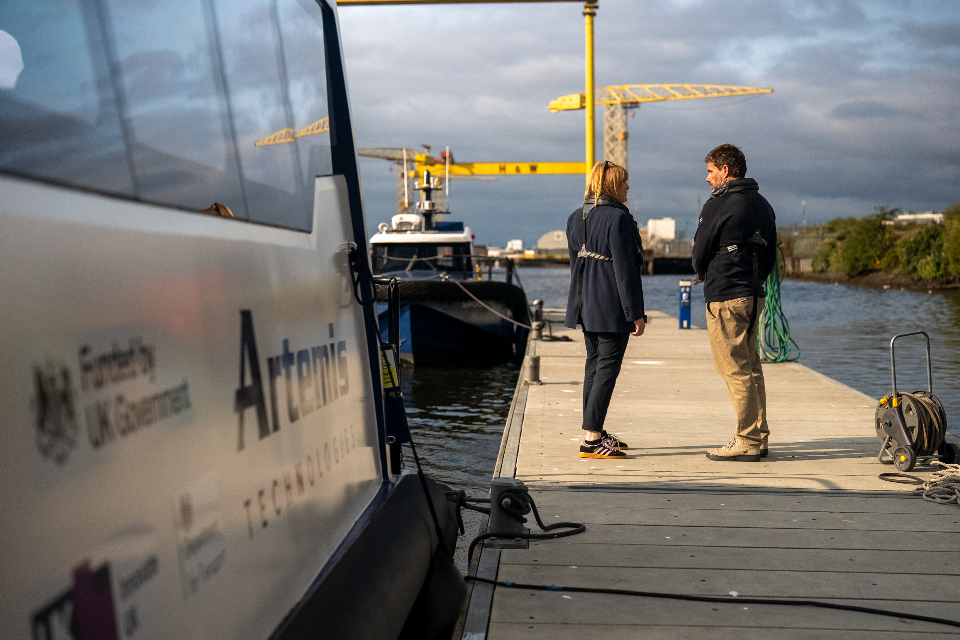- Government launches major onshore wind plan to reverse near decade of sector stagnation in England
- Boost for mission to become a clean energy superpower and protect households from global gas price spikes
- Measures to revitalise industry unlocking up to 45,000 jobs in onshore wind by 2030, through Plan for Change
The amount of clean, homegrown energy from onshore wind is set to accelerate over the second half of the decade as the government launches the first ever onshore wind strategy.
Thousands of new jobs for British people in onshore wind, such as engineering, construction, and operations maintenance, could be created by 2030 to build the onshore wind needed to deliver clean power for families and businesses.
After facing a de-facto 9-year ban in England, today’s strategy sets out over 40 radical actions to get onshore wind building again across the UK. This includes
- unlocking up to 10 GW of onshore wind by resolving issues with how onshore wind turbines and aerospace civil and defence infrastructure co-exist
- repowering of old turbines across the country, so we can maintain our current fleet and keep powering the country with clean, secure, homegrown power
- equipping planners and developers with the tools needed for the first English projects since we lifted the de facto ban last year. This includes making sure planning decisions are based on up-to-date information and ensuring site surveying and assessments for projects are more efficient to speed up decision-making
- exploring plans to expand the clean industry bonus for onshore wind, encouraging developers to invest in supply chains in the UK’s industrial heartlands, or in cleaner supply chains
Today’s strategy bolsters the strong foundations the government has built since taking office to get the industry moving again, such as lifting the ban in England and reintroducing onshore wind into the Nationally Significant Infrastructure Projects regime. These measures mean that onshore wind will be put on an equal footing to offshore wind and nuclear, meaning projects can get built quicker in the years to come.
Delivering this strategy could more than double the current onshore wind workforce, supporting up to 45,000 skilled jobs across the country by 2030, as the government pursues its clean power ambition of 27-29 GW of onshore wind by 2030.
Clean energy is the economic opportunity of the twenty-first century, and thanks to the government’s clean energy mission, investment is booming in the UK, with over £40 billion of private investment in clean energy announced since July.
Onshore wind is one of the easiest and cheapest technologies to build and will supply British homes and businesses with clean, secure homegrown power that ends a reliance on unstable global gas markets – all part of the mission to get bills down for good.
Energy Minister Michael Shanks said
Rolling out more onshore wind is a no-brainer – it’s one of our cheapest technologies, quick to build, supports thousands of skilled jobs and can provide clean energy directly to the communities hosting it.
After years of decline, we’re giving industry the tools to get building again, backing industrial renewal and secure, clean, homegrown energy through our Plan for Change.
Matthieu Hue, co-chair of the Onshore Wind Taskforce and CEO of EDF Power Solutions UK and Ireland, said
This strategy is focusing on overcoming barriers and challenges we face across the industry in the deployment of onshore wind while capturing the major socio-economic benefits it can bring to the environment and to local economies.
Together we are forging a path forward for onshore wind in Great Britain, and we are committed to ensuring a successful implementation through a new Onshore Wind Council, which will oversee the execution of the strategy. This is a critical part of making Britain a clean energy superpower and delivering energy security.
Communities are set to benefit too with the voluntary community benefits guidance for onshore wind for England being updated to provide communities with £5,000 per megawatt per year for community initiatives, such as new football pitches or libraries, or even bill discount schemes.
By delivering the upper Clean Power 2030 ambition of 29 GW of onshore wind, it’s estimated that an additional £70 million of community funding will be unlocked for rural towns and villages every year.
Today’s measures come as the government has completed a process to de-risk offshore wind developments, led by the Marine Spatial Prioritisation Programme, thus unleashing the potential for offshore wind development in the English sea in the future.
This will help guide The Crown Estate’s Marine Delivery Routemap on strategic use of the seabed to unlock offshore wind in a way that considers all marine sectors including fisheries and protects the marine environment.
This should also reduce the planning consent risk for developers on future offshore wind sites before seabed rights are tendered – speeding up and de-risking future offshore wind projects.
Stakeholders
Sue Ferns, Senior Deputy General Secretary of Prospect, said
Onshore wind has an important role to play in a secure and decarbonised energy mix so it is welcome that the government is taking steps to support its rollout.
However, the lost years resulting from the last government’s inexplicable ban have resulted in significant workforce and skills related challenges that urgently need to be addressed, which hopefully they will be in the forthcoming Clean Energy Workforce Plan.
It is also important that renewables such as onshore wind generate good, unionised jobs – if the government wants the clean energy transition to be fair and to deliver the full economic potential, it must insist on this as a condition for the support it provides.
James Robottom, Head of Onshore Wind Delivery, RenewableUK, said
Overturning the unpopular onshore wind ban, which deprived us of one of the quickest and cheapest technologies to build for a decade, was just the start. The hard work to make the most of this great opportunity to grow our economy and strengthen the UK’s energy security is now in full swing.
This strategy sets an ambitious target to almost double the UK’s onshore wind capacity by the end of the decade as a key part of the government’s Clean Power by 2030 mission.
The measures outlined will increase confidence among investors and developers, so that we can attract billions in private investment and create thousands of highly-skilled jobs and new supply chains all over the country. The strategy also sets out how people living near onshore wind farms will continue to see tailor-made community benefits through an updated Community Benefit Protocol for England, deciding for themselves the form that these benefits should take, to support and improve the lives of those in areas hosting onshore wind.
Duncan Wilson, Chief Executive, Historic England said
Historic England constructively engages with major infrastructure delivery in a way that secures good outcomes for the heritage that people care about. We therefore welcome recognition of our role and the contribution of our advice in the Onshore Wind Taskforce strategy to delivery of the renewables agenda. In line with the strategy we will be updating our commercial renewables guidance.
Claire Mack OBE, Chief Executive of Scottish Renewables, said
Scotland has a proud history in onshore wind and the bold strategy published today reaffirms how central the Scottish onshore wind sector will be to the UK’s clean power journey.
Onshore wind is a cost-effective source of clean energy that can be deployed at pace, supporting skilled jobs and tangible community benefit. Making the most of our onshore wind resource will also strengthen our energy security in the years ahead.
Scottish Renewables secured the landmark Scottish Onshore Wind Sector Deal in 2023 and the clear actions published today will build on this effort by tackling the issues that demand close working across the UK.
Renewed commitments on planning efficiency, grid connections, radar and aviation in the strategy are all strong signals of intent by the UK and Scottish governments to boost onshore wind deployment. We will work closely with all stakeholders to deliver the strategy and determine the pathway beyond 2030 for the Scottish onshore wind sector.
Lisa Christie, Head of UK Regulatory Affairs, Vattenfall, said
This government’s renewed focus on unlocking the potential of onshore wind is essential for the UK’s energy security, reducing bills, and economic growth. Proposals to resolve challenges around aviation infrastructure and to give local planning teams the tools and information they need to make faster, evidence-based decisions are especially important.
The socio-economic contribution made by renewables developers means communities also benefit from significant benefit packages that reflect local priorities. This flexibility should be maintained for future developments. Further investment can also be encouraged by ruling out zonal pricing, which risks creating further imbalances in consumer bills.
Christine McGregor, Managing Director at BayWa r.e. UK Ltd, said
We are delighted with the UK government’s leadership in convening the industry to develop the first ever onshore wind strategy. This marks a significant and timely step towards strengthening the onshore wind sector in Great Britain and advancing the ambitions of the Clean Power 2030 initiative.
Eleri Davies, Head of Onshore Wind Development (England & Wales), RWE, said
The Clean Power Action plan sets an ambitious target to double onshore wind capacity by 2030, and today’s Strategy firmly establishes the clear actions required to achieve this. We look forward to the newly established Onshore Wind Council driving these actions forward.
With over 2 decades of experience in developing and operating onshore wind in the UK, RWE knows firsthand the benefits that it can bring to host communities, with over £3.5 million awarded to local communities from onshore wind funds in the UK last year alone. Onshore wind is also one of the cheapest sources of electricity, therefore breaking down barriers to accelerate its deployment will help reduce bills for all consumers.
Laura Fleming, Country Managing Director, Hitachi Energy UK & Ireland, said
We strongly welcome moves to grow the onshore wind industry and welcome with open arms the fast deployment of affordable renewable energy. Rapid deployment is critical to delivering Clean Power 2030 and we stand ready to work with government to deliver a grid that enables the growth of the onshore wind and wider renewables sector. As a member of the Onshore Wind Taskforce, we are fully committed to capturing this opportunity to deliver clean power and industrial growth in UK.
Lucy Whitford, Managing Director UK&I Development & Construction, RES, said
The onshore wind strategy will unleash the true potential of this vital technology for the nation.
The policy direction and practical support outlined, will strengthen our energy security and support £70 million per year of extra investment in local economies across length and breadth of the country.
We’re prepared and ready to work alongside government, local authorities, industry partners and communities to implement this strategy.
Gillian Noble, Managing Director, Onshore Origination & Development at ScottishPower Renewables said
The intent, direction, and focus of this strategy is exactly what’s needed to revitalise the onshore wind industry in England, whilst also aiming to resolve key blockers to onshore wind projects already in development in other areas of the UK.
It’s been fantastic to be part of such a collaborative working group and we welcome the government’s approach in mobilising industry experts to advise and support to help push things forward. We’re excited about the potential to unlock gigawatts of onshore projects and thousands of new jobs as we contribute to the government’s Clean Power 2030 mission and beyond.
Notes to editors
See the full ‘Onshore wind strategy’.
The methodology underpinning our estimate that onshore wind could support up to 45,000 direct and indirect jobs in Great Britain by 2030 is published here Job estimates for wind generation by 2030 methodology note. It is based on achieving the upper end of the capacity range published in the Clean Power 2030 Action Plan.
The additional £70 million of community funding has been derived as the difference between the upper 29 GW ambition in 2030 and operational capacity in Great Britain as of December 2024 (15 GW), multiplied by £5,000 per MW.
The claim that onshore wind is amongst our cheapest technologies is based on a combination of sources, including the results of last year’s CfD auction (Allocation Round 6, where onshore wind cleared at a similar price to solar PV, the lowest price technology in the auction), and published evidence on electricity generation costs.
The ‘up to 10 GW impacted by aviation/radar’ is taken from the RenewableUK 2023 Survey of Onshore Wind Impacts on Aviation and Defence. This indicated that up to circa 10 GW of the future onshore wind pipeline is either currently or anticipated to be affected by objections on the grounds of interference with aviation and defence infrastructure. This figure has been rounded, and incorporates military and civil radar, and Eskdalemuir Seismic Array.
More detail on the over £40 billion of private investment in clean energy announced since July 2024 is available here ‘Clean energy industries sector plan’.








